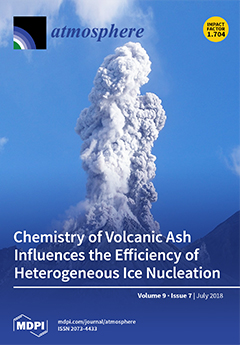From 18 February to 13 March 2014 and from 17 December 2016 to 27 January 2017, an online analyzer for monitoring aerosols and gases (MARGA) and an online single particle aerosol mass spectrometer (SPAMS) were used to measure and analyze the concentrations and sources of water-soluble (WS) ions in PM
10, PM
2.5, and gases (NH
3, HNO
3, HCl), in Shenyang City, China. During the field campaign, nine haze episodes (or smog episodes, total 582 h) were identified, with 960 identified as non-haze periods. The average mass concentrations of PM
2.5 and total water-soluble ions (TWSIs) in PM
2.5 during haze episodes were 131 μg·m
−3 and 77.2 μg·m
−3, 2.3 times and 1.9 times the values in non-haze periods, respectively. The average mass concentration of TWSIs in PM
2.5 was 55.9 μg·m
−3 (accounting for 55.9% of PM
2.5 mass loading), 37.6% of which was sulfate, 31.7% nitrate, 20.0% ammonium, 6.6% chloride, 1.9% potassium, 1.4% calcium, and 0.8% magnesium throughout the campaign. Concentrations of sulfate, nitrate, and ammonium (SNA) secondary pollution ions increased rapidly during haze episodes to as much as 2.2 times, 3.0 times, and 2.4 times higher than during non-haze periods, respectively. Diurnal variations during non-haze periods were significant, while complex pollution was insignificant. Based on changes in the backward trajectories and concentrations of WS ions, the hazy episodes were divided into three types: complex, coal-burning, and automobile exhaust pollution. All complex episodes had high concentrations and greater contributions of ammonium nitrate from complex and automobile exhaust pollution, while the contribution of ammonium sulfate from coal-burning pollution was greater than that of ammonium nitrate. The correlation coefficients among SNA species were very high in complex pollution, with nitrate and sulfate the main forms present. The results of principal component analysis (PCA) were related to emissions from burning coal for heating and from long-range transmission in winter. In the case of exhaust pollution, NO
3− accounted for the highest percentage of PM
2.5, and NH
4+ was more closely related to NO
3− than to SO
42−. Coal-burning pollution was the most common type of pollution in Shenyang. The contribution of sulfate was higher than that of nitrate. Based on PCA, the contribution of coal-burning emissions varied from 36.7% to 53.6% due to industry, soil sources, and other factors.
Full article





